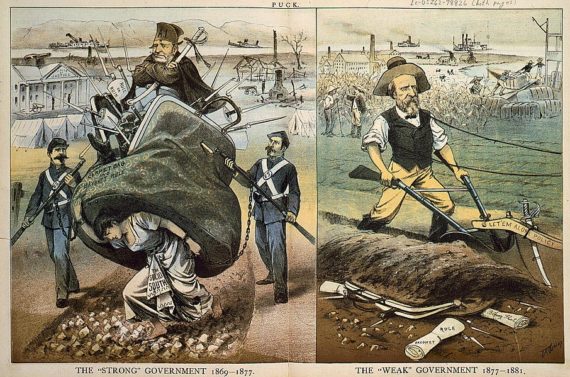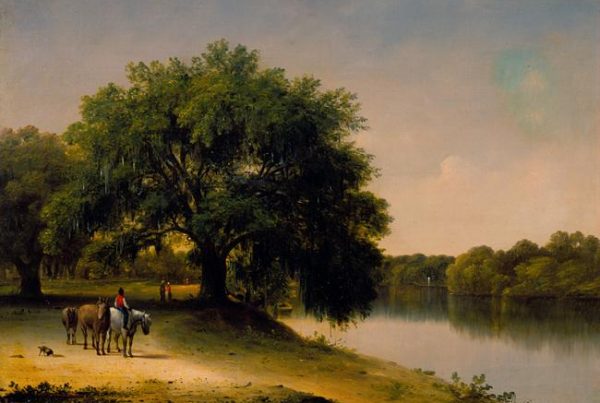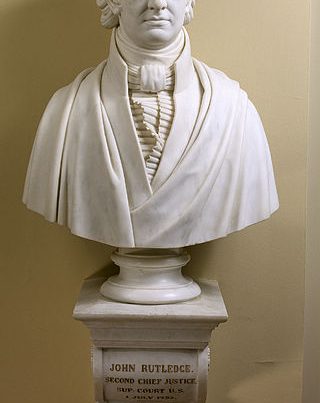[A new Southern publisher has appeared in Louisiana, Tall Men Books. Its first book is a republication of Walter Lynwood Fleming’s classic The Civil War and Reconstruction in Alabama. This is a master work of historianship that lays forth, chapter and verse, the corruption and oppression of so-called “Reconstruction.” We cannot be reminded of that too often. The following is from the Foreword by the editor George Bagby.]
Reconstruction is the single most confusing and controversial period in American history. The tinderbox of race relations and the new organization of the central government and the states were not reformed reasonably or to the satisfaction of anyone involved, or to any faction that engages the history today. Explanations and justifications for the extreme policies, punitive laws, and social experimentation of this period were, in summary, counterproductive to anything but a radical centralization of power in Washington. Ironically, the greatest advocates for ideological centralized planning are most vocal in their dissatisfaction with their progenitors. Communists and leftists openly lament that white Southerners were not herded into literal gulags or forced to emigrate. Conservative nationalists are so appalled with the record of cynicism and corruption in the “Carpetbag” governments and the Republican dominated Federal government that they struggle to maintain a thesis that any form of representative government endured it. Old republicans of Jefferson’s school can only see the period as an assault on antebellum American institutions and a less bloody form of warfare on American social life. Advocates of universal suffrage and post-ethnic utopianism find nothing but duplicitous policies forced on disenfranchised citizens. Progressives usually salve their consciences by dismissing the relevance of the ex-Confederate whites of the South. Dissatisfaction so universal has left the period neglected, and, for the past several decades, dominated by openly Marxist historians.
The progressive dominance of academia and popular memory has created an establishment interpretation: blinders that confuse needful questions and modes of inquiry about this important period. Indeed, the ideological tendencies of the establishment, in the words of Eric Voegelin, involve forbidding questions and demanding, a priori, assent to various ideological notions. This approach is the antithesis of historical inquiry, but establishment historians, such as Howard Zinn and Eric Foner, have all revealed the insecurity of their notional positions by branding their rivals with the rhetorical “devil words” of our age. They must “cancel” and malign alternatives to their own ideological vision, for permitting those essential questions and evidence about Reconstruction and the Civil War might lead to conclusions like those of the great Henry Adams of Massachusetts, who wrote that “the progress of evolution from President Washington to President Grant was alone evidence to upset Darwin.” Adams was the witness to a qualitative decline anathema to the fundamental notions of all progressives, yet this wisdom, so well-known to the ancient world and yet so exotic to Americans, is a tonic for the perplexed now that civilizational decline is a popular subject again.
The key divergence of thought lies in the ideological, a priori approach to the past and the experience-based a posteriori approach, which must take into account the irrational, organic, unchosen realities of human life. Zinn and Foner, while openly Marxist in conviction, have preyed on the timid liberals of America because liberalism itself is ideological and adverse to conversation about what experience reveals of its assumptions. The proposition of the Declaration, that all men are equal in some sense, is a basic notion in both Marxism and liberalism, and although these ideologies claim to desire different ends, liberal regimes cannot offer any resistance to ideologues of conviction and action. American institutions have been subverted and conquered by leftists in this way. American liberalism already assumed a vision of progress in history. The Whig interpretation of history, that time tracks the inevitable ascent towards enlightenment, is the dominant view. Marx shared this view, and said the goal of history is the communist utopia. American liberals believe in progress as a Christian believes in God, but cannot effectively object to Marx and critical theory to their left. American liberals will not forbid policies or professors to their left because of their uncertainty, but they have no compunction about thinkers on the right. The Marxists have spirit and vision where the liberals can only offer timid uncertainty and a vague faith in inevitable improvement.
The essential element of the a priori approach is conviction about what society ought to be, what the “American dream” or the “American ideal” must be, and whether or not a certain leader or law or event “lived up” to the ideal. This approach to the United States has abstracted the American peoples into the “exceptional” nation: a post-ethnic and ideological nation, in Lincoln’s words, “dedicated to the proposition that all men are created equal.” For these men, Lincoln is a prophet delivering a New Covenant to America. James McPherson referenced the fundamental constitutional changes of the War by terming it a second American revolution. Eric Foner calls it Lincoln’s “second founding” of the United States. Lincoln’s vision thus often influences the writing of the antebellum history of America, but no right-thinking historian ought to be preoccupied by the nonsense that troubles Americans in the present day. The historian’s task is rather to see the events of his period of study with the eyes of those who experienced the events, to understand the circumstances the way the participants understood them, and to attempt to reenact in his own mind the choices made in the past.
The refreshing alternative to this blinkered state of affairs is the so-called Dunning School of Reconstruction. Inspired by Professor William A. Dunning of Columbia University, this circle of students were inspired by Dunning’s compelling insistence on the mastery of primary sources and eyewitness accounts combined with a “scientific” approach of testing hypotheses with the evidence. Dunning had been educated partly in Berlin and had been highly influenced by John Burgess, an American professor of political science who shared the German notion of “objective” and “scientific” approaches to history. Dunning authored several works on Reconstruction, but his students and disciples found popular and scholarly fame. Aside from the unparalleled strength in primary source evidence, the Dunning School frankly communicates the history grounded in the primary sources of the particular time and place. These scholars successfully reproduced the beliefs, feelings, and experiences of various Southern and Northern states during this important period. While Foner and Stampp can communicate well how a modern leftist or Marxist feels about Reconstruction, the Dunning historians give the perspective of the Americans of the era: especially the white Southerners so recently defeated, wounded, and fleeced in the War. The Establishment can tell us what we are supposed to say about the period to earn the proper brownie points, and woe betide anyone who strays from the script. The Dunning School historians offer the experiences of normal people for normal people today, and there is no catechism of leftist doctrines to memorize. Not surprisingly, these histories have been removed from libraries and kept out of print, but that has not proved to be enough. They are ritually denounced by the encyclopedias and reference books, warning the curious away from the contagion of “wrongthink.” The time has come to make these histories accessible again.
The Dunning School men present the story of Southerners from the extant sources. They do not psychoanalyze their sources, accuse them of false consciousness, or condemn them as enemies of the people as the Marxist is obliged to do. Instead, they present their beliefs, choices, and reactions in the realistic context of the place and time. The particular strengths of these writers is in the astonishing quantity of sources they summarized, analyzed, and quoted. Their works remain the first depositories for any scholar looking for the primary sources. In addition, each historian focused on particular states and focused their efforts on the peculiarities of a place. Each history is a valuable contribution to a historiography of regionalism.
Walter Lynwood Fleming, the pre-eminent historian of the Dunning School, was a native of Alabama and son of a Confederate veteran. Born in 1874 under the carpetbag government, Fleming was a childhood eyewitness to the events he spent his career chronicling. His history is full of footnotes documenting interviews, making him an unsung pioneer of oral history. Fleming was educated at Auburn and taught high school history until the Spanish American War, when he enlisted in an Alabama regiment. He left the service as the war concluded and enrolled in Columbia University to study history under Dunning, where he earned a second MA, a PHD, and again served as a teacher. It was during these years that he composed his thesis: what he would later release as his major work.
Fleming started his career as a college professor in 1904 and accumulated further evidence for The Civil War and Reconstruction in Alabama. This work established his reputation as a scholar in the field, and enabled him later to edit and assemble The Documentary History of Reconstruction (1906).
Fleming is often disparaged today for his so-called “white supremacist” bigotry. What Fleming offers is a frank analysis of a primitive and largely illiterate people, the black Alabamans, who were suddenly emancipated, enfranchised, and made the political pawns of the Republican Party. Based as he is in the primary sources, he freely quotes and often shares the disgust and dissatisfaction of his subjects with this policy. He offers a surprising advantage over many modern writers on this period: Fleming wrote in a time when an academic was permitted to openly prefer European civilization and had no fear of doing so. Fleming is on the record preferring literacy to illiteracy, Christian marriage to concubinage, religious leadership for the seminary educated, and other cultural points. He also believed the black Alabaman capable of achievement and participation in all of these things, although most did not participate in them.
Fleming took it for granted that American institutions had been constructed by Anglo-Americans to suit themselves. He understood Reconstruction as a grotesque anomaly in which the Anglos of Alabama were disenfranchised and exploited by the military subversion of the institutions they had constructed. Few Americans of Fleming’s day disagreed with this thesis, and viewed Reconstruction as a “tragic era” in which the machinery of government was used for personal enrichment and citizenship was redefined under a military dictatorship rather than through a political process. John Burgess, in his important history of Reconstruction in 1902, illustrates the position by calling Reconstruction “an error as well as a failure,” and noting the necessity of the North to own the fact. One major difference between now and Fleming’s time is that Americans are more likely to see the radical extension of the franchise to the mostly illiterate freemen as idealistic and the disenfranchisement of ex-Confederates as deserved punishment. Even the establishment of Fleming’s own day were more likely to see the former as cynical and the latter as dishonorable and counterproductive to the peace of the Union. In the words of the historian Jeffrey Hummel, the War had emancipated the slaves, but Reconstruction had “enslaved free men.”
The association of the races is a major concern in this book as it remains in American society today. Reconstruction began a new regime of race relations which was more anarchic than orderly. Just as emancipation was made policy by force in a time of war, so enfranchisement and the proclamation of social equality were made outside of the political process and under coercion. Oddly enough, the abolition of slavery meant the end of another sort of racial integration and association. As Leon Litwack notes in his book, North of Slavery, the racial segregation regime had been invented in the states that had abolished slavery before the War and where slavery had never been a legal institution. Slavery itself was not conducive to social separation or apartheid because the institution required close proximity to function. The triumph of the Union meant the eventual importation of Northern conventions: something eventually formalized in the Jim Crowe regime, as C. Vann Woodward records. However much the end of slavery is praised, no statesman had planned what followed. Jim Crowe filled a vacuum a generation later.
Fleming’s history illustrates the countless schemes of racial integration, reconciliation, and vengeance of a time when few social norms were unassailable. Although the end of hostilities signaled the resumption of policy by mutual consent and of politics, the martial law regime and the disenfranchisement of most white men prevented politics from resuming in the South. Fleming’s meticulous documentation of the rise of the Union Leagues, the Ku Klux Klan, and other paramilitary and secret societies is of enduring interest and importance, and must be understood in the context of the unique incentives that created these movements. Vigilantism and terrorism were not confined to one side of these conflicts, and the context of the Klan’s activities deserve special attention.
Reconstruction was an episode of despotism and anarchy amid dramatic changes in the nature of the Union and of American representative government. The notion of American exceptionalism has left many with a misleading idea that the Philadelphia Constitution has maintained an unchanging regime since 1787. Whereas the French have formalized five republics, the Americans have kept their constitutional changes informal. In fact, the historian can identify several distinct regimes, and we might identify antebellum America, broadly, as an Anglo republic which conserved rather than revolutionized English institutions “by amputation” in 1776, as M. E. Bradford had it. The Declaration itself contains much evidence for this interpretation, including the famous appeal to the “consanguinity” and “common kindred” of the English people and the distinct disparagement and fear of “domestic insurrections” and the “merciless Indian savages.” The Declaration is largely a list of offences against institutions of English origin defended on enlightenment republican grounds: also thoroughly English. The Philadelphia Constitution shored up the interests of the Anglo establishment: the native elites who had organized to support their own interests “for ourselves and our posterity.” New York Federalist John Jay described this Union as one of “a people descended from the same ancestors, speaking the same language, professing the same religion, attached to the same principles of government, [and] very similar in their manners and customs.” The last and most controversial defense of this ancien regime was the Dred Scott decision of Justice Taney’s court, which argued on the best assemblage of evidence that the Founders and Framers never intended to enfranchise slaves or native Americans, but that states could expand the suffrage or amend the Constitution to do so.
If Jay saw one people united in customs and political principles, the Americans of 1861 did not, and so the organic ethnogenesis which could have resulted in a European style political partition of America was instead united by force with ideological justifications. One result of the Civil War, foreseen or not, was the abolition of the order just described, in which “those who owned the country ought to govern it,” in the words of Jay, with a new mandate of national unity and civil rights for the freemen, bypassing the enfranchisement of the native Americans for another two generations. Lincoln’s promise in the Gettysburg Address that “we here highly resolve […] on a new birth of freedom” is what M. E. Bradford characterized as a formula for a “continuing revolution” of American society and a license for unlimited power to the central government for social experimentation and engineering on ideological lines. This is the origin of the political formulas that legitimize American institutions and programs in the eyes of the masses today.
Lincoln justified his war to “save the Union” at first, and only later found it necessary to shore up his support at home and abroad by announcing the end of slavery in areas under Confederate control. Still later, in the Gettysburg Address, he revealed a more universal “dedication to the proposition that all men are created equal,” and finally in the Second Inaugural in which he remarkably posited that the abolition of slavery was the original cause and goal of the war: a goal not actually achieved until the ratification of the 13th Amendment by Southern state legislatures, eight months after Lincoln’s death. Thus, in Reconstruction, it is not surprising that Union authorities often prioritized the economic goals of the Republican Party or their own personal enrichment over the more abstract and secondary racial equalitarianism. As Fleming well illustrates, many of the race policies could be interpreted as means to an end of the demoralization of the ex-Confederates and the greater advantage of enlisting the freemen as reliable Republican voters. The fact that so many of these pledges, rumors of property redistribution, and schemes for racial integration were abandoned or used cynically while the Republican industrial and tax policies endured in law is also evidence of the revealed preference. The radical leadership in Congress did not hide their base motives of revenge and pillage, and found “waving the bloody shirt” of low passions far better political currency than more “enlightened” appeals for the radical redistribution of wealth or land for the freemen. Wealth was certainly redistributed, but it went to the victors and the infamous “carpetbagger.”
More important in the history of the Union is the narrative that joined North and South together after the War: what might be termed a nationalism to distinguish it from the looser Federalism before Lincoln’s “second founding,” in Foner’s just phraseology. The total domination of the Republicans over all three branches of the Federal Government after Lincoln’s nomination of Salmon P. Chase as Chief Justice in 1864 risked the advent of a one-party state: a goal openly advocated by Senator Thaddeus Stevens and others. The end of military government, the restoration of ex-Confederates to political office and the franchise, and the formal disbanding of the Klan that accompanied the end of military occupation was called “the return to normal conditions” by the nationalist Woodrow Wilson in his Division and Reunion [1893]. John Burgess, the professor of both Franklin and Theodore Roosevelt at Columbia, did not question the sincerity of Reconstruction policies but declared them positively counter-productive to the goal of national unity between the white citizens of the North and South. Reconciliation between the sections meant the adoption of Southern heroes into a common national pantheon and a new era of cooperation and a measure of prosperity shared with the South. This was a peace with honor for the defeated, and Southerners returned to service, as before, disproportionately filling the ranks of the military in infantry bases named after Southern as often as Northern generals.
This former peace settlement, an actual realization of the “malice towards none and charity for all” among the white Americans who remained the principal actors of the drama and the overwhelming majority of residents in the Union, is obviously over. Another regime has taken its place, prioritizing the placement and status of minorities of all species and institutionalizing grievances. It is in this climate that Woodrow Wilson is as unwelcome a witness as Walter Fleming: both men are honest and authoritative testaments of another time in which heritage Americans retained a will to rule and saw no reason to shrink from their dominion.
The sound historian does not find his bearing by the fashionable ideology, but by the organic realities of the period he studies. His task is not to credit or condemn past actions in reference to present politics or dogma, but to illustrate what was believed, what was chosen, and what was done in the circumstances of his chosen period. Fleming is a master of this academic approach, and he undeniably lends it the pathos of a native Alabaman whose sources are respected elders. Fleming’s achievement is beyond most historians: he intimately knows and sincerely loves the people who are his subjects. The sordid tale of Reconstruction is full of villains and men reduced to their lowest moments, and yet Fleming presents them humanely with mixtures of motives, and does not reduce or dismiss any personality with the rhetorical “devil words” that block the sentiments against understanding an unfamiliar and distant time. Our historian is a master of his craft, his material, and his place in the world. He well exemplifies Clyde Wilson’s description of history as “somebody’s story.” This is the tragic story of the people of Alabama between 1860 and the end of Reconstruction, and it is unmatched in excellence.







A great column. Very informative on this era that I heard my elders make reference to as a child but with very, very few specifics that lead to understanding the hard feelings expressed.
Thank you Mr. Bagby!
A friend, a lady who I’ve only recently really come to know, moved to my county in south side Virginia from the west coast in the early 1970s. I was just a kid. An historian, writer and restorer of old homes, she undertook to compile and edit the county’s history, ultimately to be published in the ’80s. There’s a valuable section on the War and much of the rest relates to it and the years of reconstruction.
She told me just days ago, when it came to gathering information, stories and anecdotes on the War and its aftermath she couldn’t get people to talk about it. A century removed from the War’s end – in her words, “senses were still raw”.
Great information. Thanks, Gordon!
In 1881, Tuskegee Institute was funded by an Alabama legislature composed entirely of White Southern Males, the vast majority of these men being former Confederate Soldiers.
More great information. Thanks, William!
Very fine stab at a whole lotta mess, Mr. Bagby. Thanks!!
Where can we find the publisher and the book please?
From among others: amazon, eBay and AbeBooks.
Plenty to choose from. Prices vary depending on hardcover/paperback, condition and edition, etc..